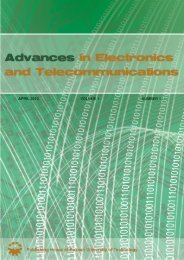november 2010 volume 1 number 2 - Advances in Electronics and ...
november 2010 volume 1 number 2 - Advances in Electronics and ...
november 2010 volume 1 number 2 - Advances in Electronics and ...
Create successful ePaper yourself
Turn your PDF publications into a flip-book with our unique Google optimized e-Paper software.
KREHLIK et al.: PRECISE MEASUREMENTS OF HIGHLY ATTENUATED OPTICAL EYE DIAGRAMS 69<br />
Fig. 5. Eye diagram of weak signal register directly on the oscilloscope (a), <strong>and</strong> us<strong>in</strong>g the described system (b).<br />
Fig. 6. Eye diagram obta<strong>in</strong>ed at the end of same optical l<strong>in</strong>k for vary<strong>in</strong>g<br />
EDFA amplification.<br />
<strong>in</strong> oscilloscope noise, as shown <strong>in</strong> Fig. 5a. Us<strong>in</strong>g the presented<br />
system, the clear eye was obta<strong>in</strong>ed, as shown <strong>in</strong> Fig. 5b. Now<br />
some signaldistortions,causedbytheresidualdispersion,may<br />
be precisely observed. In the experiment the laser cooler was<br />
turned off, so the ambient temperature variations affected the<br />
transmission delay. The ma<strong>in</strong> eye displayed <strong>in</strong> Fig. 5b was<br />
taken with the auto-align<strong>in</strong>g option turned on, <strong>and</strong> the <strong>in</strong>set<br />
shows the smeared eye diagram obta<strong>in</strong>ed without align<strong>in</strong>g.<br />
The eye diagrams presented <strong>in</strong> Fig. 6 were obta<strong>in</strong>ed for a<br />
l<strong>in</strong>k consist<strong>in</strong>g of the transmitterdescribedabove,the boost<strong>in</strong>g<br />
erbium doped fiber amplifier (EDFA) <strong>and</strong> 70 km of dispersion<br />
compensated fiber. Three measurements were performed for<br />
various EDFA ga<strong>in</strong>s. The eye shown <strong>in</strong> Fig. 6a was obta<strong>in</strong>ed<br />
for low amplification, result<strong>in</strong>g <strong>in</strong> 5 dBm power at fiber<br />
<strong>in</strong>put. This time the output eye was clearly opened, with only<br />
small over- <strong>and</strong> undershoots observed. For higher amplification<br />
the signal distortions become evident (Fig. 6b), <strong>and</strong><br />
f<strong>in</strong>ally, for even higher amplification, the output eye pattern<br />
was completely destroyed (Fig. 6c). This way an evident<br />
manifestation of fiber nonl<strong>in</strong>earities was observed. (The eye<br />
diagram measured at EDFA output had still the same shape.)<br />
It should be po<strong>in</strong>ted out that the reference eye diagram, taken<br />
with the lowest amplification, could not be obta<strong>in</strong>ed without<br />
the presented measurement system, because of the weakness<br />
of the fiber output signal.<br />
V. SUMMARY<br />
A solution for measur<strong>in</strong>g the highly attenuated optical eye<br />
diagrams is presented <strong>in</strong> the paper. It is dedicated for use <strong>in</strong><br />
situations when the optical or electrical amplification of the<br />
received weak optical signal is impossible or is suspected of<br />
<strong>in</strong>troduc<strong>in</strong>g some undesired artifacts.<br />
The ma<strong>in</strong> idea is to repeatedly transmit each data pattern<br />
to allow measurement noise reduction by means of averag<strong>in</strong>g,<br />
<strong>and</strong> to overlap all registered patterns afterwards. The idea of<br />
cop<strong>in</strong>g with the possible transmission delay w<strong>and</strong>er is also<br />
proposed. The practical implementation of the measurement<br />
system <strong>and</strong> realized experiments verify the usefulness of the<br />
solution.<br />
REFERENCES<br />
[1] “DSA8200 Digital Sampl<strong>in</strong>g Oscilloscopes,” [onl<strong>in</strong>e],<br />
http://www.tek.com/products/oscilloscopes/.<br />
[2] G. Sikorski, “Stanowisko do automatycznego sterowania i akwizycji<br />
danych dla cyfrowego oscyloskopu sampl<strong>in</strong>gowego,” Master’s thesis,<br />
AGH, Kraków, 2007.







